Mr. Hironobu Tsujiguchi (辻口博啓) is the most well-known pastry chef in Japan. His sweets boutiques in Tokyo, including its flagship store Mont St. Clair, are always filled with clients who look for the best French-style pastry products. After his success in Tokyo, he opened two new style units, called “LE MUSEE DE H”, in Ishikawa prefecture where he was from. One of them is accommodated in Ishikawa Prefecture Museum of Art (石川県立美術館) building, based in Kanzawa.
Le Musee de H offers an interesting “modern tea ceremony” program produced by the master chef Mr. Tsujiguchi. On the program “Concept G”, “marriage” of Japanese tea and French-style sweets is expressed in a designed modern “tea room” which is attached to the sweets boutique and cafe floor of Le Musee de H. Mr Tsujiguchi coordinated the space and the program as a whole for Concept G, from a course of tea ceremony services to tea cups, interior of the modern tea room. Let’s try a new world of Japanese tea and Japanese tea ceremony!
“G” of Concept G represents “Gyokuro” (玉露), the highest quality brand of Japanese greaan tea from Kyoto. During the course, Gyokuro green tea is served 3 times in each different way in addition to seasonal tea upon starting and grilled tea at the end. The chef Mr. Tsujiguchi selected 3 plates of sweets that are the best match with Gyokuro tea.
Welcome plate, ice cream with Japanese sweets specialities such as kinako (きなこ, soy beans sweet powder) and kuromitsu (黒蜜, black syrup etc), served with seasonal “Sakura tea”, made from cherry tree leaves.
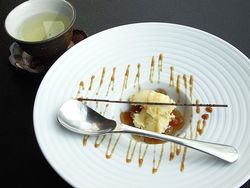
A staff brought to me a pot with a small candle and a plate of green leaves on top as well as a wooden stick. This is for whay?
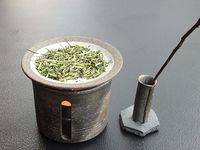
It is the first surprise...I was asked to have these tea leaves grilled by myself while enjoying cups of Gyokuro green tea. This is the first time for me (and maybe many of Japanese clients come here) to roast tea leaves. It is actually required carefull attention to mix these leaves time by time so they are evenly burned. Sometimes a few leaves were out from the plate and another leaves were burned too much...
During Concept G program, tea is prepared with this traditional-style tea making tools by staff.
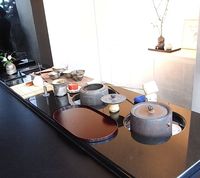
The first cup of Gyokuro green tea is served with a small cup like Sake. Surprisingly the taste of the highest quality tea is totally different from what we have usually as green tea. It is rich and includes “umami” (うまみ). The shiny black cup for the best green tea served on a silver plate. This is like art...

The second cup of Gyokuro tea, following the surprise, is not same with the first cup, even though they are from same tea pot and leaves.

The main dessert plate includes three fantastic sweets. The cake is Gateau Opera “Sakura flavor”.
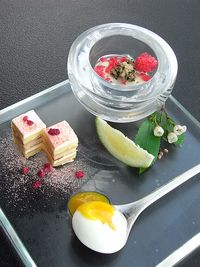
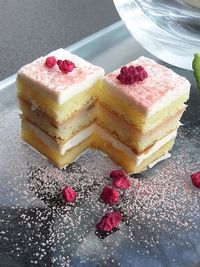
Another surprise was a small plate sesrved...
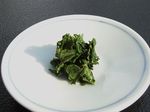
It is tea leaves for the seasonal tea. Normally we just throw away tea leaves after tea is made, while as for the special seasonal sakura tea, it is edible and good with a drop of soy sauce (shoyu)! It was enough good and like boild leafy vegetable.
Finally this is the tea which “I grilled by myself”. Of course it is absolutely tasty too.
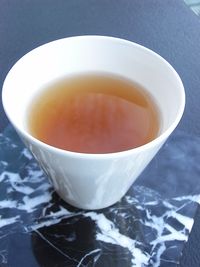
I really enjoyed for apploximately an hour of Concept G world and surely I did discover great combination of Japanese tea and very nice sweets. This is what we cannot have in Tokyo but the concept really well matchs with Kanazawa city’s atmosphere. So it is better to travel to Kanazawa even from Tokyo.
Concept G program is takens place every hour from 11h00 to 17h00 at Le Musee de H in Kanazawa. Advance reservation is recommendable to secure a time slot.
After the tea ceremony, let’s try to find some cakes and cookies for souvenir.
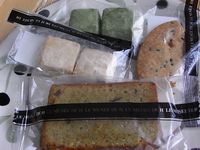
Some products are made with local ingredients. Cake in Kaga Bo-cha (Kaga stick grilled tea), Neige Shoyu (square snow-cookies, soya sauce flavor), Neige Nakajimana (square snow-cookies, local leaf vegetable flavor), Goroshima Kintoki (local sweet potatos) cooky
Concept G, modern tea ceremony program will be followed by a newer post about another unit of Le Musee de H in Wakura Onsen town.
Le Musee de H, Kanazawa (in the building of Ishikawa Prefecture Museum of Art)
*No museum entrance fee required to visit onlyt the sweets shop.
Address: 2-1, Dewa-machi, Kanazawa-city, Ishikawa Prefecture
Website: http://www.kagaya.co.jp/le_musee_de_h/contents/kanazawaConcept.html
*The place is in Kanazawa, Hokuriku region. (not in Tokyo) For general information about Kanazawa and how to get there, please visit below link.
http://aboutfoodinjapan.weblogs.jp/blog/2011/04/about-kanazawa-city-where-food-lovers-should-not-miss-on-travel-in-japan.html
大きな地図で見る
Accommodations close to the sites mentioned on this post
|
It must be fun if we could make Japanese traditional sweets by our own hands. Even in Japan, it is rarely possible but at Kanko Bussankan (観光物産館) in Kanazawa, the hope comes true!!
On weekend in the morning to early afternoon, Japanese sweets making experience program is taken place by a professional sweets-making master in Kanazawa. The lecture is provided in Japanese but I guess even for non-Japanese speakers that could go fair, because the way of making is largely showed in visual step by step by the master in person and through the screens placed around the hall. As long as you pay enough carefully attention on how the master use his hands and tools at each step, mostly you will find how to do there.
All necessary tools and ingredients were ready in front of us when we were seated.
What is important before seated, please wash your hands off well! because your hands are the most useful tool to make the Japanese sweets.

Today’s teacher to give us the class is the sweets making master comes from Takagiya (高木屋), founded in early 20 century.

We were going to make three kinds of cake made with beans paste.
White and green dough of beans paste are rounded in a ball.

It is almost like a play with clay when we had in childhood. But it is important for sweets making to make the shape quickly as much as possible in order to keep the ingredient cool.
The ball shape paste was wrapped with a wet cloth.
I squeezed the top of the ball tightly as instructed... then it has been transformed to “a butterbur sprout” (ふきのとう fukinoto, an icon of early Spring season).

We wondered how we use this net for making sweets with beans paste.

The master showed the way to make the yellow paste into small pieces by getting the dough gone through mesh. Then the small pieces were attached on to a filling dough paste.
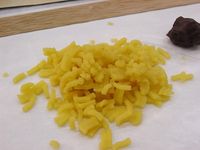
These are my works in colors!

Green – Fukinoto (ふきのとう, butterbur sprout)
Pink – Sakura (桜, cherry blossom petals)
Yellow – Nanohana (菜の花, field mustard)
The program is taken place at Kanko Bussankan (local specialies souvenir shop) just beside of Kenrokuen garden from morning to early afternoon, on 30minutes to 1hour interval during weekend (Saturday, Sunday and bank holidays). It is reservable at the hall reception on site or by phone in Japanese.
Sweets to be made at the class is changed day by day depending on masters and company who provide lesson. The three pieces of sweets made by yourself as well as a piece made by professional can be taken away for your tasting after the experience program.
Related links: Takagiya (高木屋) who provided the lesson on the day
http://www.takagiya.jp
Venue: Kanko Bussankan (観光物産館)
Information about the sweets making experience (in Japanese) :
http://kanazawa.ftw.jp/gaiyo.html
Nearest bus stop: Kenrokuen Shita (兼六園下)
Address: 2-20, Kenrokuen-machi, Kanazawa-city, Ishikawa Prefecture
*The place is in Kanazawa, Hokuriku region. (not in Tokyo) For general information about Kanazawa and how to get there, please visit below link.
http://aboutfoodinjapan.weblogs.jp/blog/2011/04/about-kanazawa-city-where-food-lovers-should-not-miss-on-travel-in-japan.html
大きな地図で見る
Accommodations close to the sites mentioned on this post
|
Japanese traditional sweets (和菓子, Wagashi) is also one of the biggest features of Kanazawa. The sweets making in Kanazawa had been developped with tea ceremony school in Edo period under the governance by Maeda Family which had deep knowledge and patronage to the Tea ceremony culture.
Some traditional sweets producers in Kanazawa continuously run their business over hundreds years since the period. We are able to find their great works at sweets boutiques in the city. To know more about the history and culture of sweets making in Kanazawa, Kashi Bunka Kaikan (菓子文化会館, Confectionery Museum) is open to tourists. It is located between two major tourist spots, Omicho Ichiba and Higashi Chaya. So it will be a good stroll to visit these three spots in a day by taking bus or walk when the weather is fine.
The Confectionery Museum shows old financial records in town to tell how sweets producers were appreciated in Edo period. Sweets making tools in these days were also found. It also introduces different types of Japanese traditional sweets which are served at sesonal events or at rites of life passage.
Some items can be touched directly. They are wooden molds used to make Rakugan (落雁, sugar candy beautifully embossed). I guess they are NOT former tools but still in use at some traditional houses.
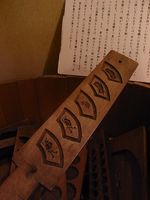

Goshiki Nama Kashi (五色生菓子, Five colors of unbaked cakes)
Traditional cakes to be made for wedding celebletion. The five colors represent “bounty in the universe” (天地の恵み, tenchi no megumi);
 日 (Sun) –red and white cake, reflecting sun rising scene
日 (Sun) –red and white cake, reflecting sun rising scene
月 (Moon) – round shape white cake
海 (Ocean) – ellipse shape of waves in white
山 (mountains) – round cake, yellow rice grains dusted
村里 (people’s village) – black round shape made of steamed Yokan (beans paste cake)
At the last part of the exibihtion, amaging works by modern masters are displayed. Can you imagine the flower decorations are made with “sugar”!
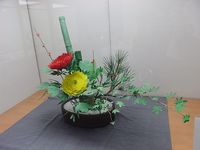
I will also introduce another interesting spot for sweets lovers in following posts.
Related link – Kanazaa Tourist Information Guide
http://www.kanazawa-tourism.com/eng/guide/guide1_3.php?no=6
Kashi Bunka Kaikan (菓子文化会館, Confectionery Museum)
Address: 2-12-1 Owara-cho, Kanazawa-city, Ishikawa Prefecture
*The place is in Kanazawa, Hokuriku region. (not in Tokyo) For general information about Kanazawa and how to get there, please visit below link.
http://aboutfoodinjapan.weblogs.jp/blog/2011/04/about-kanazawa-city-where-food-lovers-should-not-miss-on-travel-in-japan.html
大きな地図で見る
Accommodations close to the sites mentioned on this post
|
I got an interesting souvenir from Kyoto. It is described as "Nishonshu bonbon"(日本酒ボンボン, sake candy) on the red label pasted on a white paper box. Many of us know "whiskey bonbon" or chocolate with whiskey inside. I am also curious more for the words "Jizake" (地酒, locally-brewed alcohol) and the branded sake production area "Fushimi" (伏見) in Kyoto.

Opening the box, I found white frosted-glass like candies filled.
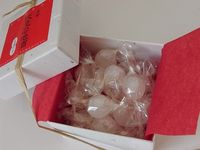

It is much more delicate than glass and is broken soon after being put in mouth.
Then "sake" liquid spreded from the sugar taste shell...
What an inetersting way is to taste locally brewed sake from Fushimi, Kyoto.
The Nihonshu bobon is made by a local pastry company called Furansuya (in Japanese, meaning "French house") based in Kyoto for decades and the sweets is sold at gift shop(s) in JR Kyoto station.
Official website of Furansuya (Japanese only) http://www.furansuya.jp
Saint Valentine's day is commercially made in Japan as the date when girls give chocolate to their loved boys. For a few weeks until the 14th of February, sale of chocolate is the most increased in a year. You will find special corners of chocolate gift everywhere in this season. Some people enjoy finding favourite chocolate brand from wide selections of high quality chocolate in this season not for gift to someone but for herself.
I found another attempt of Saint Valentine's day at a supermarket. It is "Chocolate Brewery" or chocolate beer made by collaboration between a major Japanese beer producer Sapporo and a well-known high quality chocolate brand ROYCE in Hokkaido region.
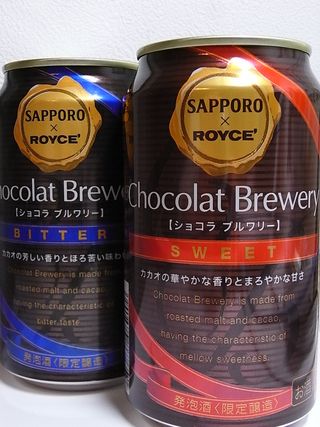
Once I had chocolate beer in Alsace, French city but where is influenced by German culture and is beer-production region. The unique point for the case in Japan is that the beer is made with ROYCE brand chocolate which is solely established as a high quality chocolate producer from Hokkaido.
Anyway let's taste the chocolate beer in Japan. There are two types by taste; Sweet and Bitter. I took Sweet type for me.
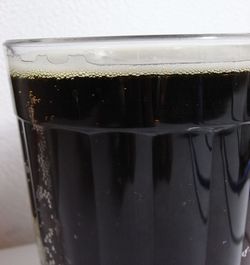
Color is close to black color or dark brown chocolate.
Taste, YES, it surely and interestingly has CHOCOLATE flavor.
Instead of sweet flavor, bitter taste is felt less than usual beer.
Its alcohol ratio is 5% less than normal beer.
Uhhh...in other words, it could be sensed as if it was soft drink as same as Coca-cola.
Be careful not to have it too much. It is alcohol drink...
Chocolate Brewery SAPPORO x ROYCE is not regular product. It means that it is sold for limited time and limited amount. How much and how long is not announced though. The product is sold at some liquor shops, convenience stores and supermarkets.
Official website of the product Chocolate Brewery (Japanese) :
http://www.sapporobeer.jp/chocolat/
Official website of ROYCE (English), though the beer is not sold at the chocolate boutique maybe:
http://www.e-royce.com/english/
Since last night, it has been chilly and we had snow in Tokyo
It snows in many places across Japan yesterday and today.
On such a cold day, we have "ice cream" to have.
Yukimi Daifuku (雪見だいふく)
It is, if I translate into English, "Snow viewing ice cake".

Daifuku (大福) is originally a kind of traditional sweets made from sticky rice cake and sweet beans paste. Vanilla ice creame, instead of sweet beans paste is wrapped by soft thin white rice cake in the case of Yukimi Daifuku.
Both rice cake skin and ice cream filling are pure white color like snow.


I like to enjoy Yukimi Daifuku in warm indoor place , while snow is falling outside.
, while snow is falling outside.
Yukimi Daifuku can be found at major convenience stores and supermarkets in Japan during winter season. I miss the sweets sometimes in summer time...
Yukimi Daifuku Japanese website: http://www.yukimidaifuku.jp
Gion Tokuya (ぎおん徳屋) is a very traditional style dessrt cafe in Kyoto, where Maiko (舞妓) and Geiko (芸妓) could also visit there for sweets and relaxed tea time. The new branch of Gion Tokuya opened in Harajuku (原宿), Tokyo last year. Here maybe no chance to encounter Geiko or Maiko in Harajuku but a good point is no need to make a queue like the main shop in Kyoto. (At least as long as I know but in future I do not know though...)
 In Tokyo, Gion Tokuya is located on the ground floor of the well-known select shop, UNITED ARROWS. The sweets cafe is accessible even from the floor of Women's cloth in the select shop.
In Tokyo, Gion Tokuya is located on the ground floor of the well-known select shop, UNITED ARROWS. The sweets cafe is accessible even from the floor of Women's cloth in the select shop.
Entering into the small cafe, it is totally different world from the popular select shop. The traditional style interior decoration makes us feel as if we were visiting Kyoto.
What I ordered is Tokuya's speciality called "Hanami Komochi" (花見こもち). It is a set of mochi (餅, rice cake) with five kinds of ingredients all well-matched with mochi.
As soon as we ordered the speciality, the shop staff switched on a brasier on the table. It is guests who has to bake eight pieces of rice cakes on the brasier.
How exiting is it I worry a bit whether I am able to succeed in cooking these rice cakes.
I worry a bit whether I am able to succeed in cooking these rice cakes.
Anyone will be motivated for the challenge when she/he finds a plate of five kinds of topping ingredients brought by staff.
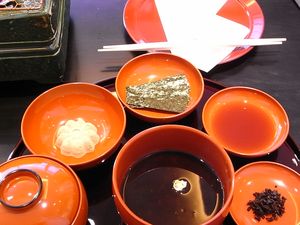 Zenzai (a kind of Oshiruko, sweets beans soup) is in a bowl on the center of tray. Other ingredients, from left to right, in counterclockwise, pickles of Japanese basil seeds, soy sauce (醤油), laver seaweed (海苔, nori), kinako (soybeans powder).
Zenzai (a kind of Oshiruko, sweets beans soup) is in a bowl on the center of tray. Other ingredients, from left to right, in counterclockwise, pickles of Japanese basil seeds, soy sauce (醤油), laver seaweed (海苔, nori), kinako (soybeans powder).
As you like, those eight pieces of mochi (rice cake) can be taken, piece by piece.
Let's try to make mochi cakes grilled.
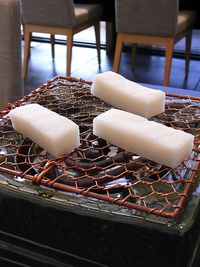
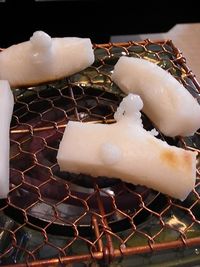

Can you see? Afre five minutes, the square and hard cakes are heated and they are blown up like a balloon. When they become partly brown by heat and no longer square shaped cake, it is ready to eat. Take them out from the brasier quickly.
First I dipped a few pieces into Zenzai.
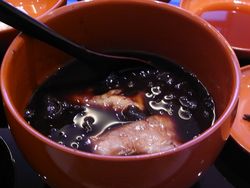
Then with soy sauce (醤油) and nori
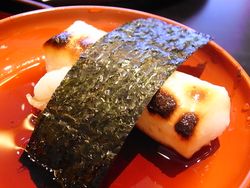
Kinako (soy beans powder) is set beautifully in flower shape.
But it has to be broken into pieces, after mochi is put on the plate...
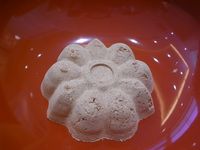
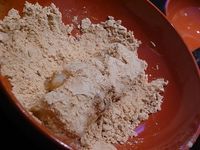
All are the typical ways of having mochi. It is not so often to try so many pieces of mochi in different flavor. It is fun but you might have too-much-cooked and burned mochi in case you leave them on a brasier too long time, while thinking over what kind of flavor you prefer. At the same time, when we leave mochi left after cooked without having heat, the cakes become cool and hard soon. Just cooked is the best timing to have it. So it is important to keep appropriate pace of grill and to put pieces one by one.
It is a kind of dessert but rice cake has heavy volume which is enough to be a light lunch.
Gion Tokuya in Harajuku offers not only Hanami Komochi set but also other traditional sweets menu such as Warabi mochi (わらび餅), Anmitsu (あんみつ) and Kakigori (かき氷). Normally mochi is served only in winter and Kakigori is only in summer. Here at Gion Tokuya, all these desserts are provided whole year.
Related story:
Oshiruko (おしるこ、汁粉) http://aboutfoodinjapan.weblogs.jp/blog/2011/02/oshiruko-%E3%81%8A%E3%81%97%E3%82%8B%E3%81%93-%E6%B1%81%E7%B2%89.html
Shoyu (soy sauce, 醤油) http://aboutfoodinjapan.weblogs.jp/blog/2011/01/shoyu-%E9%86%A4%E6%B2%B9-soy-sauce-at-website-shokunin-shoyu-%E8%81%B7%E4%BA%BA%E9%86%A4%E6%B2%B9.html
Kakigori (かき氷) http://aboutfoodinjapan.weblogs.jp/blog/2009/08/kakigori---chim.html
Cafe name: Gion Tokuya (Harajuku, Tokyo)
Website: http://www.united-arrows.jp/harajuku/womens/tokuya/
Address: 2-31-12 Jingumae, Shibuya-ku, Tokyo
大きな地図で見る
Cafe name: Gion Tokuya (Kyoto the main store)
Website: http://giontokuya.jp/
大きな地図で見る
Oshiruko (お汁粉) is sweet hot soup made from red beans and sugar. It is often served in winter particularly at outdoor events such as marathon or other sports gathering. The sweet and hot dessert makes our body warmer.
I found an interesting pack of Oshiruko at Kaldi Coffee farm in Tokyo. It is called "Okoge shiruko" (おこげしるこ, brown shiruko). Three pieces of round white ball looks like dumpling (団子, dango) in a row in a pack.
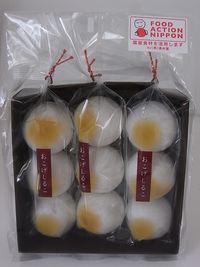
The small pack may be a good souvenir for international traveler.
After I brought the pack to my home, I made instant Oshiruko as it is instructed on the recipe.
Let's prepare a bowl and a pack of Okoge Shiruko.
I use a miso soup cup for it....

Put the three pieces into the bowl.

With spoon, break the balls into small pieces...

Inside of the white crispy ball, lumps of brown powder is there.
It was hard and required some power to break down into pieces.
Pour 100ml of boiled water.

Finally Oshiruko is ready

It is quick and easy...Just with boiled water and a bowl.
Okoge shiruko is produced by a traditional sweets house in Nagoya.
I found the pack at Kaldi Coffee shop but not sure until when it is available and at which units.
Otherwise Okoge shiruko is sold through online store of the producer Enshuya from October to March.
Company site: Enshuya http://enshuya.jp
Online store of Enshuya http://engasane.jp/SHOP/EN-C-0004.html
Kaldi Coffee Farm: where various interesting food grocery both international and Japanese are available as well as fine coffee beans. Many of them are situated in residential area across Japan, while two units are in Tokyo central area, Omotesando and Shinagawa.
http://www.kaldi.co.jp
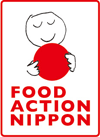 Link to Food Action Nippon
Link to Food Action Nippon
I found a cute oasis inside of busy JR Tokyo station, where every day Shinkansen and local trains run in and out a number of times and where thousands of people come by. The cafe is located on a part of commercial zone called "Gransta" on the basement 1 (B1) floor of JR Tokyo station.
As the name "Fairycake Fair" shown, fairycake is the cafe's speciality. Fairycake is British traditional homemade-like cup cake inherited from grandmother to mother then to daughters. The cup cakes by Fairycake Fair is produced by the sweets specialist Romi Igarashi, being added "flavour" of modern Tokyo to the traditional British cakes.
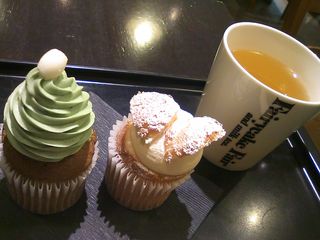
What I had here...from left,
Cup cake "Uji Maccha" (宇治抹茶 green tea from Uji, Koyoto),
Cup cake "Shio Caramel" (塩キャラメル salty caramel),
drink Kaga bocha (加賀棒茶, grilled "bar" tea from Kaga)

Inside of the most popular Shio Caramel cup cake
Two types of caramel cream are used.
The rich caramel cream inside of the cake and whipped soft shio caramel cream on-top of it.
Cakes are enough small to eat up two pieces as a tea time. So let's try more than one flavors of cutely decorated cup cakes at a time. Some other interesting cup cakes are available depending on seasons. On current season, they are, for example, "ginger lemon" and "apple cinamon". As drink, Milk tea, the most popular drink in England, and "hot yuzu honey" (Yuzu, Japanese citrus, juice with honey), house original ginger ale are also interesting choices.
During winter holiday season from Emperor's birthday (the 23th of December) to the end of New year holidays (until the third of January or around), JR Tokyo station is more crowded than other periods for Japanese locals travelling out to their hometown or to resort destinations, skiing, hot springs.
Have a break before/after taking a train at the peaceful cute cafe inside of JR Tokyo station.
But be careful not to miss your train for the cup cakes!
Cafe name: Fairycake Fair
Address: B1 Gransta JR Tokyo Station, 1-9-1 Marunouchi, Chiyoda-ku, Tokyo
Website: http://www.fairycake.jp
大きな地図で見る
![]()
For some products sold at Le Musee de H, some of the region’s local ingredients are used; Noto milk, eggs, Kaga bocha (grilled stick tea), rice harvested in Wajima and natural salt.

